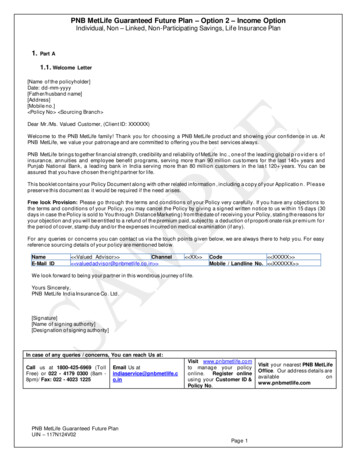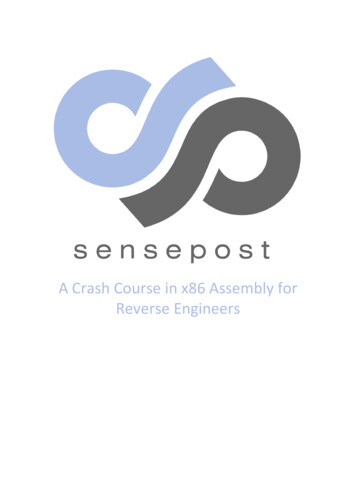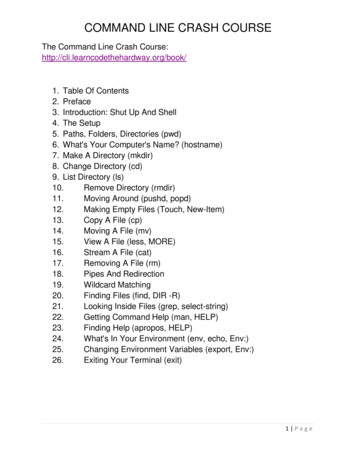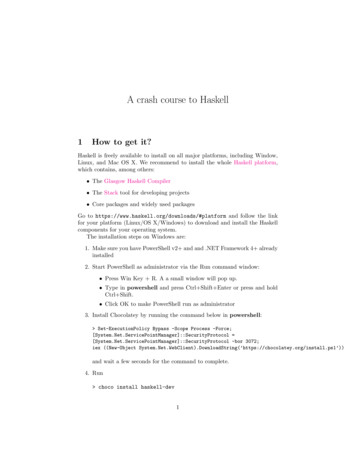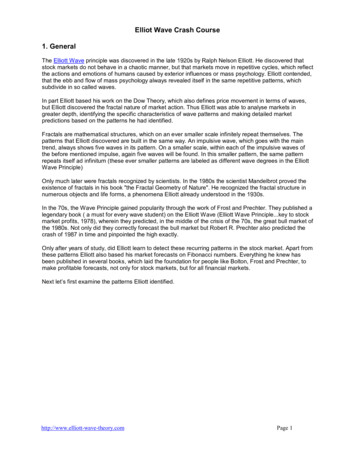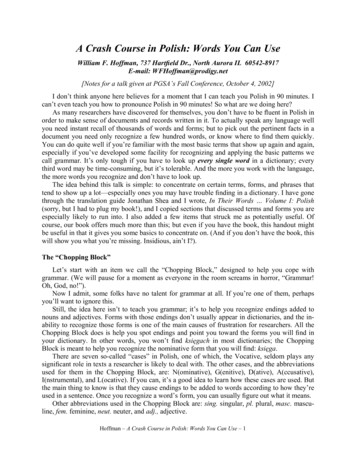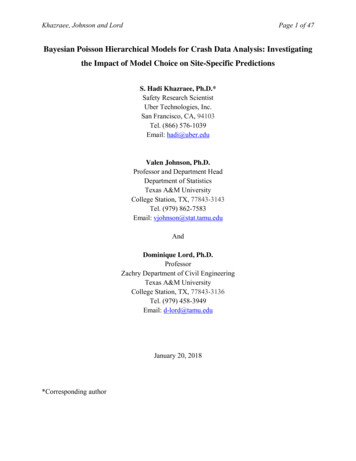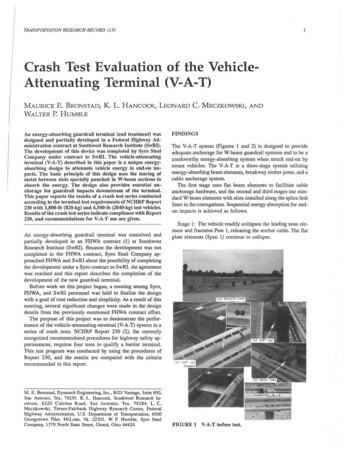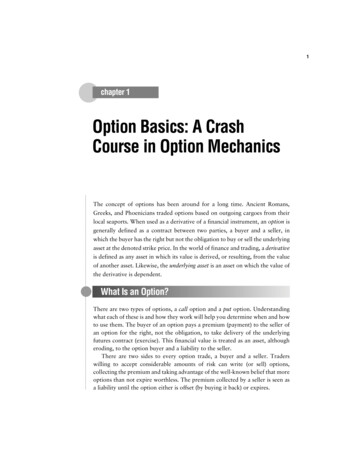
Transcription
02 0137142862 ch01.qxd12/17/082:38 PMPage 11chapter 1#Option Basics: A CrashCourse in Option MechanicsThe concept of options has been around for a long time. Ancient Romans,Greeks, and Phoenicians traded options based on outgoing cargoes from theirlocal seaports. When used as a derivative of a financial instrument, an option isgenerally defined as a contract between two parties, a buyer and a seller, inwhich the buyer has the right but not the obligation to buy or sell the underlyingasset at the denoted strike price. In the world of finance and trading, a derivativeis defined as any asset in which its value is derived, or resulting, from the valueof another asset. Likewise, the underlying asset is an asset on which the value ofthe derivative is dependent.What Is an Option?There are two types of options, a call option and a put option. Understandingwhat each of these is and how they work will help you determine when and howto use them. The buyer of an option pays a premium (payment) to the seller ofan option for the right, not the obligation, to take delivery of the underlyingfutures contract (exercise). This financial value is treated as an asset, althougheroding, to the option buyer and a liability to the seller.There are two sides to every option trade, a buyer and a seller. Traderswilling to accept considerable amounts of risk can write (or sell) options,collecting the premium and taking advantage of the well-known belief that moreoptions than not expire worthless. The premium collected by a seller is seen asa liability until the option either is offset (by buying it back) or expires.
02 0137142862 ch01.qxd212/17/082:38 PMPage 2Trading Commodity Options Call options—Give the buyer the right, but not the obligation, to buy theunderlying at the stated strike price within a specific period of time.Conversely, the seller of a call option is obligated to deliver a long positionin the underlying futures contract from the strike price should the buyerchoose to exercise the option. Essentially, this means that the seller wouldbe forced to take a short position in the market upon expiration. Put options—Give the buyer the right, but not the obligation, to sell theunderlying at the stated strike price within a specific period of time. Theseller of a put option is obligated to deliver a short position from the strikeprice (accept a long futures position) in the case that the buyer chooses toexercise the option. Keep in mind that delivering a short futures contractsimply means being long from the strike price.CallPutBuyLimited RiskSellUnlimited RiskTo understand what an option is, you need to know the various componentsthat comprise it. This next section explains the following: Strike price Intrinsic and extrinsic value Time value, volatility, and demandStrike PriceMost literature doesn’tinclude strike price as afactor of determining theextrinsic value of an option.It is assumed that the strikeprice is built into thesupply and demandequation of the option.Naturally, a strike pricecloser-to-the-money will bein higher demand.The strike price is the price at which the buyer of a calloption has the right to purchase the futures contract, or thebuyer of a put option has the right to sell a futures contract.This is also referred to as the exercise price.The strike price is one of the biggest factors in determiningboth the extrinsic and intrinsic value of an option. Obviously,the closer the strike price is to the underlying futures contractthe more valuable the option will be, even if there is nointrinsic value. This makes sense, because the closer the strike
02 0137142862 ch01.qxd112/17/082:38 PMPage 3Option Basics: A Crash Course in Option Mechanics3price is to the underlying market the better the odds are that the option will expirein-the-money and the higher the demand will be for the contract.Intrinsic and Extrinsic Value: Components of anOption PriceThe value of any given option is composed of two components: Intrinsic value Extrinsic valueOption Price Intrinsic Value Extrinsic ValueIntrinsic ValueThe intrinsic value of an option is the amount thatthe market price is higher than the strike price for acall and lower than the strike for a put. In otherwords, the intrinsic value is the amount of moneythat the option would be worth if it expired today. For the option to haveintrinsic value, the option must be in-the-money.In-the-money and out-of-the-money are often falsely usedIt is important to know andunderstand the terminologyby beginning traders. Many traders refer to a profitable optioninvolved in commoditytrade as being in-the-money. However, this is not the case. Antrading; this could help tooption can be in-the-money and not profitable. Likewise it canavoid costly mistakesbe out-of-the-money and be a profitable trade.stemming from miscommunication between you andCall options are described in the following wayyour broker. In-the-money(see Figure 1.1):Intrinsic value is what youwould have if the optionexpiration was today. In-the-money—The futures price is above the strike price. At-the-money—The futures price is at the strike price. Out-of-the-money—The futures price is below the strikeprice.is a commonly misusedterm. Many beginningtraders use this phrase torefer to a profitable traderather than the intrinsicvalue of the position.
02 0137142862 ch01.qxd412/17/082:38 PMPage 4Trading Commodity OptionsIn-the-Money(Intrinsic Value)At-the-MoneyOut-of-the-MoneyXFigure 1.1 The intrinsic value of a call optionPut options are described in the following way (see Figure 1.2): In-the-money—The futures price is below the strike price. At-the-money—The futures price equals the strike price. Out-of-the-money—The futures price is above the strike rinsic Value)XFigure 1.2 The intrinsic value of a put option
02 0137142862 ch01.qxd112/17/082:38 PMPage 5Option Basics: A Crash Course in Option MechanicsAs shown in the Figure 1.3, the intrinsic value increases tickfor tick as the market moves beyond the strike price of theoption. In this case, it is a corn call option with a strike price of 2.70. With the market at 2.80 the option has an intrinsicvalue of 10 cents; with the market at 2.90 the option has anintrinsic value of 20 cents, and so on. It is important to realizethat before expiration the option value will not be equal to theintrinsic value because it will also have extrinsic, or time, value.5The intrinsic value of anoption can easily be calculated, but the extrinsic valueof an option is impossibleto estimate at any giventime in the future other thanexpiration. This is becausethe extrinsic value is madeof a combination of time,volatility, and demand.Figure 1.3 The intrinsic value of a 2.70 corn call with the market at various pricesExtrinsic ValueExtrinsic value is based on a combination of the strike price, time, volatility, anddemand. We like to think of extrinsic value as the “icing on the cake.” Due tothe nature of its components, it is impossible toestimate extrinsic value. Beginning traders often askExtrinsic value is like “icingquestions such as, “If I buy a call and the marketon the cake.”goes up x number of points, what will it be worth?”Unfortunately, the answer depends on factors that can’t necessarily be measuredquantitatively.
02 0137142862 ch01.qxd612/17/082:38 PMPage 6Trading Commodity OptionsExampleIf a trader buys a September 6.00 soybean call option for 10 cents in June with theunderlying futures price at 5.80 and the market rallies to 6.00 by the beginning ofJuly, the option will likely be worth much more than the original premium paid. After all,there will still be a lot of time value left on the option and the option is now at-themoney.Example IIIf a trader buys the same option, in the same circumstances, but it takes the underlyingfutures until August to reach 6.00, the trade will likely be a loser. More time premiumwould have eroded from the option value than it would have benefitted from the marketbeing closer to the strike price.As you can see, it is possible to be right in the direction of the market andstill lose money on a long option trade. This is exactly why it is so difficult tomake money as an option buyer. It is hard enough to be right, but direction isonly the first obstacle.The extrinsic value of an option is based on a combination of the followingfactors: Time Volatility DemandOf these factors, time is the only predictable element. You know what theysay, “Time waits for no man.”Throughout this book we will cover several hands-on examples to illustratethe risks and potential rewards involved with each strategy and scenario. It isimportant to realize that all calculations are based on the assumption that thetrade is held until expiration. This is because at expiration the options will haveno extrinsic value, which is nearly impossible to predict at any given point. Atany time prior to expiration, the profit or loss experienced on the trade may beoutside the original profit and loss parameters based on the price of the underlying contract at option expiration. This is especially true in the case of optionspreads.Time ValueThe longer the amount of time until an option’s expiration, the greater the timevalue of a particular option will be. This makes sense, because the longer the
02 0137142862 ch01.qxd112/17/082:38 PMPage 7Option Basics: A Crash Course in Option Mechanicsbuyer possesses the right to exercise the option the morevaluable that right is. Remember, in commodity tradinganything can happen. It is not out of the question for arelatively worthless option to come to life and post abnormalgains (or losses for the seller) by expiration. Keep in mind thatthis is the exception rather than the rule, but it can and doeshappen.7Time value works againstthe buyer of an option, butworks for the seller. This isbecause the time valueportion of the option isconstantly eroding untilreaching zero at the time ofexpiration.VolatilityIf the price of the underlying futures contract is fluctuating considerably, thereis both a greater profit and a greater loss potential. Thus options tend to be moreexpensive to buy when volatility is high. Likewise, sellers willVolatility can be a doublecollect more premium for a short option during times ofedged sword. It can beinflated volatility. Of course, premiums are high for a reason—lucrative if you are in athe risk and reward are equally magnified.Trading Volatilityfavorable position, butlosses may be substantial ifyou happen to be on theopposite side. This is thecase whether you areholding long or shortoptions.Because of the effect volatility has on option premium, it is agood idea to buy options when the market is quiet and sellthem in times of high volatility. Those holding long optionsduring an explosion in volatility have been known to enjoy impressive profits.On the other hand, short option traders may find themselves in a less thandesirable position should they be in a market that experiences significantincreases in volatility after they have entered a position.DemandIf the number of traders willing to buy an option at a given price is greater thanthe number of traders willing to sell the same option, the value of that optionappreciates. It is the nature of the option markets toexperience high demand of call options in a marketSome traders look to be thethat is in an uptrend and high demand of put optionscontrarians of the masses. Ifin a downtrend. Thus, it is not uncommon to seeeveryone else seems to beoverpriced options in such scenarios. An interestingbuying the option, it may bephenomenon in the equity indices, put options aretime to sell it.almost always priced high to comparative calls. This
02 0137142862 ch01.qxd812/17/082:38 PMPage 8Trading Commodity Optionsis partly due to equity holders hedging their portfolios along with the expectation that markets drop faster than they go up. You may have heard the conceptof higher put valuation referred to in the context of a “volatility smile” or“skewed volatility.” In the case of equity indices the implied volatility of an atthe-money option is often less than that of an out-of-the-money option, ornegatively skewed. This is especially true in the case of distant strike priced puts;interestingly, this didn’t seem to be the case until after the crash of 1987.If you are unfamiliar with the term implied volatility, it is important to notethat the term differs greatly from market volatility (often referred to as historicalvolatility). Historical or market volatility is a direct measure of price movement,while implied volatility is a function of the derivative value (option premium)itself rather than the underlier. Therefore, options with differing strike prices orexpiration dates but based on the same underlier may have differing levels ofimplied volatility. The formal definition of implied volatility is, in its simplestform, the volatility implied by the market price of the optionAnother component of demand is strike price.Strike price is obviously one of the biggest factors in the market’s determination of option value. The closer to the money an option is, the more valuableit is to the buyer and the riskier it is to the seller. This makes sense; people arewilling to pay more for an option that seems to have a better chance of payingout than they would for an option that will most likely expire worthless. As wecover in great detail throughout this book, the delta value of an at-the-moneyoption is 50 and has roughly 50 percent odds of expiring in-the-money.The Art of Option TradingIn options trading the infamous adage “There ismore than one way to skin a cat” holds true. Manytraders choose to ignore technical or charting toolsand focus on market fundamentals. Yet others lookstrictly at chart formations to construct trades.Regardless of the market analysis tools used, wehave found that traders can increase their odds ofsuccess by beco
This is especially true in the case of option spreads. 6 Trading Commodity Options Time Value The longer the amount of time until an option’s expiration, the greater the time value of a particular option will be. This makes sense, because the longer the 02_0137142862_ch01.qxd 12/17/08 2:38 PM Page 6. buyer possesses the right to exercise the option the more valuable that right is. Remember .File Size: 540KBPage Count: 10
